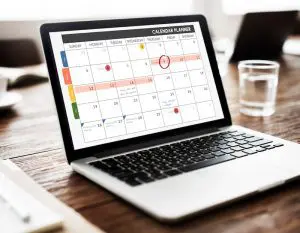Have you ever reached the end of your workday and realized you’ve only completed half of what you planned to do? Yet, you were busy all day and had the stress level to prove it. So, what happened?
Author and businessman Stephen Covey explained it well: “It’s incredibly easy to get caught up in an activity trap, in the busy-ness of life, to work harder and harder at climbing the ladder of success only to discover it’s leaning against the wrong wall. It is possible to be busy – very busy – without being very effective.”
An online scheduling software for small businesses is an excellent starting point for targeting efficiency. However, learning to use it to your advantage is essential to your overall productivity. Here are some tips to take control of your workday using your appointment setter software:

(rawpixel.com/Freepik)
Be Clear On Your Objectives
You can only measure how close you are to your goal if you are crystal clear on what that goal is. An unclear purpose also leaves you vulnerable to a busywork trap. Decide what must get done, break it down into manageable steps, and schedule those steps so busywork doesn’t fill your calendar.
Give Yourself Enough Time
People often underestimate how long it will take to complete a project. Allow for learning curves, interruptions, travel time, and appointments arriving a few minutes late. Utilize the function to build buffers between scheduled appointments to account for longer than anticipated meetings, client tardiness, and any other frequent delays.
Sync Your Devices
An appointment scheduler for small businesses should be accessible from your laptop, desktop, phone, tablet, or any other device you frequently use. If you have an appointment away from the office, accessing your calendar (and the attached address and driving instructions) from your phone is a lifesaver. Ensure all devices support your security software or use an encrypted cloud-based scheduler to protect your clients and business.
Make Your Calendar Accessible
Ensure you share your calendar with employees who could interfere with your appointments. By using an online calendar, you can share it while maintaining privacy, so it will just show busy and available windows to people without full access.
For example, you schedule a staff meeting, but an employee doesn’t read their email before agreeing to a face-to-face meeting with a client. The employee could miss the staff meeting or irritate a client by rescheduling the appointment. If you both worked off the same calendar and blocked the staff meeting time, the employee would automatically choose a time that doesn’t interfere with your plans. Additionally, if someone sets an appointment with you, you don’t accidentally double-book the time slot.
Schedule Your Busywork
Answering emails is vital so you don’t miss communications with clients or coworkers. However, if your email is the first thing you do in the morning, you can get sidetracked from the day’s most important tasks. The same goes for answering mail and other mundane daily activities. Do what’s most important first and let the busywork take what’s left.
Prioritize Breaks
Your peak concentration level is estimated to last 45 minutes to an hour before productivity lessens. Take a 5-10 minute break. You can use this time to stand up, stretch, get a drink, or do a small task that requires less attention before returning to projects that require heavy concentration. You’ll make fewer mistakes, prevent circulation issues, and lessen neck and back discomfort.
Schedule collaborations
You can schedule collaboration times if you need to utilize more than one team member or another advisor on a project. With real-time updates, everyone on the team can see any changes to the schedule, even if they work in different locations.
Use Automatic Reminders
Here are a few examples of possible uses and benefits for this helpful feature:
- Reminders for appointments will give you enough lead time to accommodate traffic or prep work.
- Meeting reminders to all staff members will help everyone arrive on time.
- Maintenance and software update reminders will help you remember to leave computers on overnight so it doesn’t take up time in your work day.
- Project due date reminders and milestone deadlines will help keep you on track to complete the project on time.
- Busy work reminders ensure you leave enough time at the end of the day to catch up on correspondence and other tasks that don’t require as much brain power.
- Daily, weekly, monthly, or yearly repeated task reminders like preparing for inventory counts, filing times, or applying for extensions frees up brain space to focus on tasks you can’t automate.
Automate The “Do Not Disturb” Function
If you’re in an appointment, other people in the office know to call you when the meeting is over. You can set emails to auto-respond, letting clients and coworkers know you will attend to their email or call when you return so they don’t think you’re ignoring their communication. This is especially important if you’re out of town at a conference and it will be a few days before you respond.
Your electronic scheduler can keep your company on the right track, improve productivity, and help you reach your goals faster. Play around with the features to find the functions best suited to your business. You can color code types of appointments so it’s easy to see on the calendar or send notifications, mark tasks with high priority levels, and write notes you need on hand for your job or appointment. Don’t be working as your calendar tool; take the time to set it up so it works for you.



